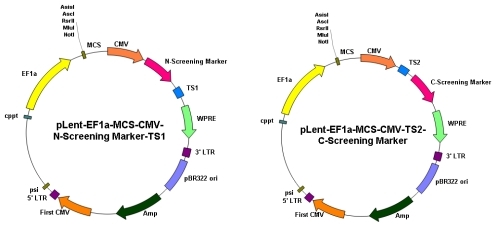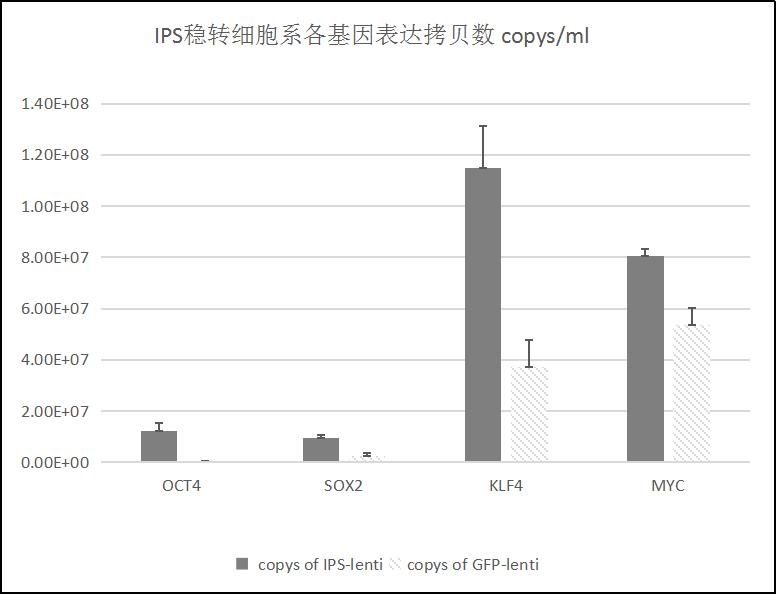Split screening labeling lentivirus system
Background Introduction
In the fields of scientific research and cell engineering, constructing stable expression cell lines often requires achieving stable co expression of multiple genes. Currently, commonly used strategies include multiple infections, multiple isolation screening, etc. However, this approach has many drawbacks: ① the number of screening markers available in eukaryotic cells is limited; ② Long experimental period; ③ Simultaneously using multiple different screening genes may have adverse effects on cells; ④ Multi gene linkage, low virus packaging efficiency; The above questions pose challenges in terms of time and cost for screening stable transgenic strains with multiple gene co expression. Therefore, it is necessary to develop new technological means to solve the above problems.
Weizhen Biotechnology has established a division screening system that can easily and quickly achieve multi gene co expression!
Principle of Split screening labeling system
Divide a screening marker into N-terminal and C-terminal parts, connect intron splice junctions TS1 and TS2 respectively, construct two lentiviral vectors, and then transduce the two vectors into cells. Some cells' gain nothing 'during this process, some cells' uptake' one of the vectors, and some cells' uptake 'both vectors. Only when two vectors containing N-terminal and C-terminal screening markers are simultaneously "taken up" by one cell, will the N-terminal and C-terminal screening markers be linked at the mRNA level to form a complete screening marker, thereby expressing the complete screening marker protein. And those cells that do not "uptake" into the carrier, or only "uptake" into one carrier (i.e. the two carriers of N-terminal and C-terminal screening markers do not enter one cell), are eliminated due to the inability to express a complete screening marker protein within the cell.
Figure 1. Schematic diagram of the principle of split screening and labeling
R&D route
01 Construction of dual lentiviral vectors
02 Validation of transfection effect on cells
03 Packaging of lentivirus
04 Screening of stable cells
05 Validation of stable cell lines
Dual vector spectrum
Figure 2. Schematic of the lentiviral dual-vector system.
Rapid and efficient preparation of IPS cells using the split screening marker lentivirus system
Induced pluripotent stem cells (IPS cells) refer to the use of gene transfection technology to introduce certain transcription factors into animal or human somatic cells, and reprogram terminally differentiated somatic cells into embryonic stem cell (ESC) - like pluripotent cells. Nowadays, pluripotent stem cells are mostly obtained by viruses carrying specific transcription factors into somatic cells. In 2006, Shinya Yamanaka from Kyoto University in Japan first reported on the study of induced pluripotent stem cells in the world-renowned academic journal Cell. They cloned four transcription factor genes, Oct3/4, Sox2, c-Myc, and Klf4, into viral vectors and introduced them into mouse fibroblasts. They found that they could induce their transformation, and the iPS cells produced were similar to embryonic stem cells in morphology, gene and protein expression, epigenetic modification status, cell doubling ability, embryoid and teratogenic ability, differentiation ability, and other aspects.
However, the current methods used by researchers to generate induced pluripotent stem cells are time-consuming and inefficient. When introducing four transcription factors into adult cells such as skin cells, only a few iPSCs can be obtained using thousands of skin cells. Therefore, we attempted to use the newly established lentiviral stable transformation system with division screening markers to simultaneously express the above four transcription factors and obtain stable transformation cell lines in a short period of time.
Figure 3. Screening IPS stable cell lines using the split screening marker lentivirus stable transformation system
Experimental plan and results
Firstly, we divided the four transcription factors into two groups and constructed them into the aforementioned dual lentiviral vectors, obtaining lentiviral plasmids pLent-Ef1a-Ort4-P2A-Sox2-cmv-N-Puro (IPS-N-Puro) and pLent-Ef1a-Klf4-P2A-Myc-cmv-C-Puro (IPS-C-Puro). Subsequently, these two lentiviral plasmids were co transferred into 293A cells and subjected to Puro screening to observe cell growth. As shown in the figure below, setting up the experimental group and the control group, we found that after Puro pressurization, a large number of cells in the empty cell group died, while the cell survival rate was higher in the experimental group and the control group. This result indicates that a large number of lentiviral vectors entered the same cell, and antibiotic genes were expressed normally, allowing a large number of cells to survive.
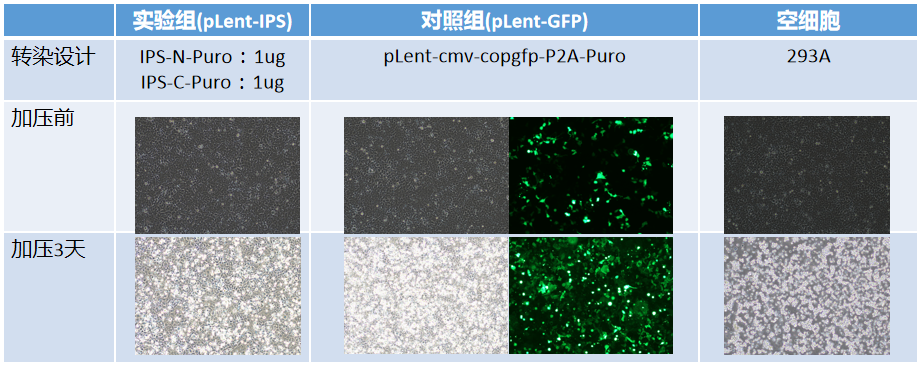
Subsequently, we quantitatively detected the mRNA expression levels of four transcription factors in the experimental group and control group cells, as shown in the figure below. We found that the mRNA expression levels of the four transcription factors in the experimental group cells were significantly higher than those in the GFP control group, which also supports the above conclusion. A large number of lentiviral vectors entered the same cell, and the four transcription factors achieved high expression.
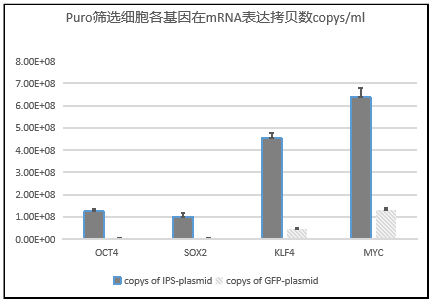
Next, we packaged the two lentiviral vectors as lentiviruses and co infected 293A cells, as shown in the figure below. We set up an experimental group and a control group. After 72 hours of infection, we added Puro for screening. We found that the blank group cells (5) and the single lentiviral infection group cells (2, 3) showed a large number of deaths, while the experimental group (1) and GFP group (4) that "took up" the dual virus had significantly higher cell survival rates than the two virus infection groups. After one week of screening, we successfully obtained a large number of stable transformed cells.
Lentivirus
|
Vector
|
Titer
|
IPS-N-Puro
|
pLent-Ef1a-Oct4-P2A-Sox2-cmv-N-Puro
|
7.19E+08 IU/ml
|
IPS-C-Puro
|
pLent-Ef1a-Klf4-P2A-Myc-cmv-C-Puro
|
1.87E+09 IU/ml
|
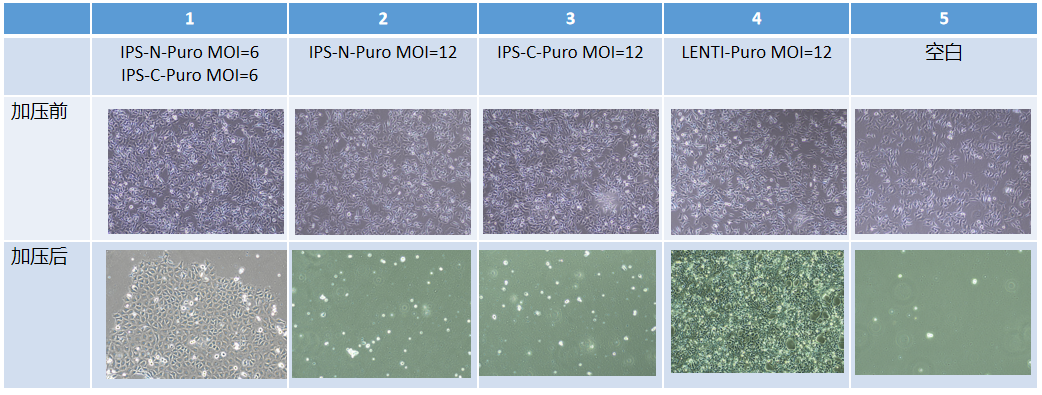
Similarly, we quantitatively detected the mRNA expression levels of four transcription factors in cells from the co infection group of two viruses and the GFP lentivirus control group. The results were consistent with those obtained from plasmid transfection, and the mRNA expression levels of the four transcription factors in cells from the co infection group of two viruses were significantly higher than those in the GFP control group. The results also confirmed the above conclusion, indicating the successful construction of stable transgenic cells with co expression of four genes.
brief summary
Weizhen Biotechnology has successfully established a lentivirus stable transformation system that can achieve division screening markers. It can use one screening marker to select multiple transgenes, making the co expression of multiple genes simpler and more convenient, and can construct stable transformation cell lines of multiple genes in a short period of time. At present, we have successfully obtained stable transgenic cell lines of induced pluripotent stem cells with stable expression of four transcription factors using this system. In addition, the system can also be used for positive cell selection in CRISPR/Cas9 genome editing for double transgenic or double allele knockout.
Welcome teachers to inquire and place orders!





